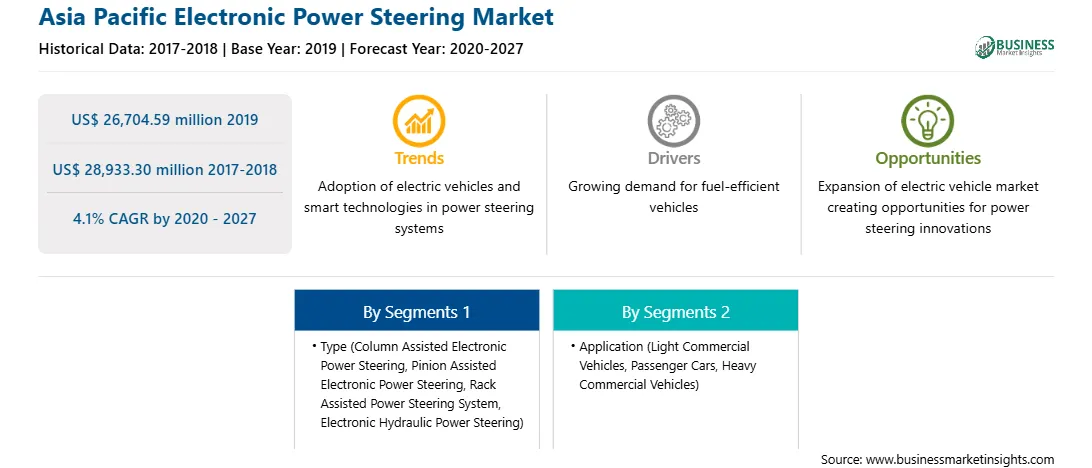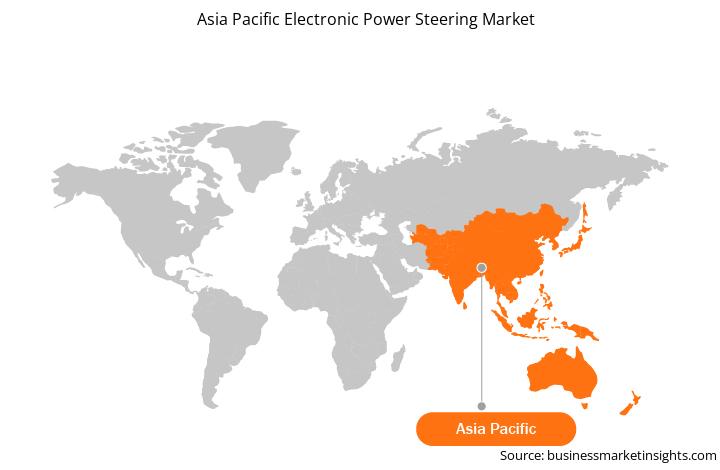亚太地区的 EPS 市场细分为中国、印度、日本、澳大利亚、韩国和其他地区亚太地区。个人可支配收入的增长加上经济的增长,导致过去几年乘用车和商用车的销量激增。该地区已成为制造业中心,拥有强大的汽车工业。中国制造 2025 和印度制造等政府举措推动了亚太地区该行业的增长。东南亚国家基础设施建设、国内消费增长以及低廉的劳动力成本是吸引汽车企业落户该地区的关键因素。从污染物排放来看,与柴油车相比,电动汽车的表现非常出色,尤其是在轻型和重型商用车方面。优化自动驾驶汽车预计将成为印度、马来西亚、新加坡和泰国等亚太地区国家电动汽车的重要推动力。因此,这些国家强大的汽车制造业预计将在未来几年支持该地区 EPS 市场的增长。此外,中国高档汽车销量的增长正在推动亚太地区电子动力转向市场的发展。
亚太地区受到新冠肺炎 (COVID-19) 疫情的严重影响。该地区发展中国家众多,经济前景乐观,工业发达,人口众多,可支配收入不断增加。所有这些因素使亚太地区成为各个市场、电子动力转向市场的主要增长驱动区域。该地区不断增长的在线购物者和不断增长的电子商务行业为亚太地区电子动力转向市场的增长提供了有利可图的机会。 COVID-19 大流行的后果和影响可能会更严重,并且完全取决于病毒的传播。亚太地区各国政府正在采取可能的措施,通过宣布封锁来减少疫情的影响,这对市场产生的收入产生了负面影响。印度是该地区领先的制造业之一,也是亚太地区受影响最严重的国家。该地区的几个市场在过去三个月出现了负增长。封锁阻碍了印度汽车行业的发展。日本和韩国仍在抗击新型冠状病毒,这是电子助力转向市场增长放缓的关键因素。然而,中国已经能够稳定住新冠肺炎 (COVID-19) 的传播,各行业也都在正常运转。这为电子助力转向市场的稳定带来了积极的迹象。
亚太地区电子助力转向市场预计将从2019年的267.0459亿美元增长到2027年的289.333亿美元;预计 2020 年至 2027 年复合年增长率为 4.1%。电动汽车 (EV) 的能耗最低,因为它们通过电池运行,而与内燃机相比,电池使用的电动机效率本质上更高。亚太地区的几家制造商正致力于确保新注册的欧盟车队到 2030 年限制每公里平均二氧化碳排放量,否则将受到处罚。电动汽车的销售为原始设备制造商 (OEM) 提供了获得额外积分来实现其目标的机会,并通过将限制严格程度降低最多 5% 来简化合规性。例如,2019年,日本批准了一项规定,在2030年之前收紧轻型车辆(LDV)的燃油经济性标准。这项新标准要求车辆到2030年企业平均燃油效率达到约3.95升/100公里(WLTC测试)因此,亚太地区各国政府越来越多地实施标准以及对节能车辆的要求不断提高是推动亚太地区电子动力转向(EPS)市场的重要因素之一。
从类型来看,2019年C-EPS细分市场引领亚太电子助力转向市场。从应用来看,乘用车细分市场引领亚太电子动力转向市场2019 年转向市场。
准备本报告时提到的一些主要一手和二手来源有关亚太地区电子助力转向市场的报告包括公司网站、年报、财务报告、国家政府文件和统计数据库等。报告中列出的主要公司有现代摩比斯、捷太格特株式会社、万都株式会社、三菱电机株式会社、耐世特汽车、NSK Ltd.、罗伯特·博世有限公司、昭和株式会社、蒂森克虏伯股份公司、采埃孚股份公司。
购买报告的理由
Strategic insights for Asia Pacific Electronic Power Steering involve closely monitoring industry trends, consumer behaviours, and competitor actions to identify opportunities for growth. By leveraging data analytics, businesses can anticipate market shifts and make informed decisions that align with evolving customer needs. Understanding these dynamics helps companies adjust their strategies proactively, enhance customer engagement, and strengthen their competitive edge. Building strong relationships with stakeholders and staying agile in response to changes ensures long-term success in any market.

| Report Attribute | Details |
|---|---|
| Market size in 2019 | US$ 26,704.59 million |
| Market Size by 2027 | US$ 28,933.30 million |
| Global CAGR (2020 - 2027) | 4.1% |
| Historical Data | 2017-2018 |
| Forecast period | 2020-2027 |
| Segments Covered |
By 类型
|
| Regions and Countries Covered | 亚太地区
|
| Market leaders and key company profiles |
The regional scope of Asia Pacific Electronic Power Steering refers to the geographical area in which a business operates and competes. Understanding regional nuances, such as local consumer preferences, economic conditions, and regulatory environments, is crucial for tailoring strategies to specific markets. Businesses can expand their reach by identifying underserved regions or adapting their offerings to meet regional demands. A clear regional focus allows for more effective resource allocation, targeted marketing, and better positioning against local competitors, ultimately driving growth in those specific areas.

Some of the leading companies are:
The Asia Pacific Electronic Power Steering Market is valued at US$ 26,704.59 million in 2019, it is projected to reach US$ 28,933.30 million by 2027.
As per our report Asia Pacific Electronic Power Steering Market, the market size is valued at US$ 26,704.59 million in 2019, projecting it to reach US$ 28,933.30 million by 2027. This translates to a CAGR of approximately 4.1% during the forecast period.
The Asia Pacific Electronic Power Steering Market report typically cover these key segments-
The historic period, base year, and forecast period can vary slightly depending on the specific market research report. However, for the Asia Pacific Electronic Power Steering Market report:
The Asia Pacific Electronic Power Steering Market is populated by several key players, each contributing to its growth and innovation. Some of the major players include:
The Asia Pacific Electronic Power Steering Market report is valuable for diverse stakeholders, including:
Essentially, anyone involved in or considering involvement in the Asia Pacific Electronic Power Steering Market value chain can benefit from the information contained in a comprehensive market report.